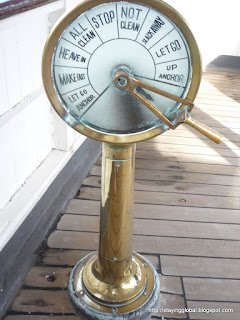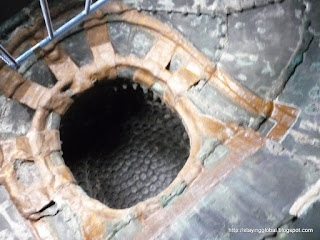On
our trip to Kamakura, we stopped by in Yokohama for a couple of hours. We
mainly visited the Yokohama Bay area.
The promenade offers a good view of the Harbour and the Minato Mirai skyline.
A walking path leads to the Rinkosen promenade which passes by the Osanbashi pier and leads to Minato Mirai area.
Most people visiting Yokohama make it a point to stop by at the Chinatown.Chinatown is the place to be if you want to experience a bit of China. Lots of shops sell Chinese antiques, crafts and knickknacks. Not to forget, Chinese food too.
Yokohama is also home to Anpanman Museum, themed around characters from the “Anpanman” anime series, popular among young children.
Hard to miss are the red “Akai
Kutsu” buses which are a good option to tour the Minato Mirai, Yamashita Park,
Motomachi and Chinatown. A ride costs 100 yen while a day pass costs 300 yen.
Jinrikisha's are also available for a joyride near the Yamashita Park/China town area.
Yokohama's sidewalks have some interesting tile work.
Yokohama
was once a sleepy fishing village which turned into one of Japan’s most
important ports. Today, Yokohama is Japan’s second biggest city after Tokyo in
terms of population. The first railway line in Japan was laid between Tokyo and
Yokohama. Its proximity to Tokyo makes it sort of a twin city and a business
hub.
Our
first stop in Yokohama was the NYK Hikawamaru.
The NYK Hikawamaru is an old Passenger liner which also served as a Hospital ship during the World War II. During its time as a Passenger liner, the Hikawamaru made 238 voyages across the Pacific to Seattle and Vancouver. Today the NYK Hikawamaru is anchored at the port and has turned into a sort of museum which is popular judging by the number of visitors it attracts. Visitors get to walk inside the ship and get a feel of the voyage.
A few rooms like the luxury suites are not open for entrance, but one surely gets to look inside. Famous passengers include members of the Imperial family and even Charlie Chaplin.
The NYK Hikawamaru is an old Passenger liner which also served as a Hospital ship during the World War II. During its time as a Passenger liner, the Hikawamaru made 238 voyages across the Pacific to Seattle and Vancouver. Today the NYK Hikawamaru is anchored at the port and has turned into a sort of museum which is popular judging by the number of visitors it attracts. Visitors get to walk inside the ship and get a feel of the voyage.
A few rooms like the luxury suites are not open for entrance, but one surely gets to look inside. Famous passengers include members of the Imperial family and even Charlie Chaplin.
It is 106 meters high and has an observatory at 100 meters above
ground. It is supposedly the largest inland lighthouse in the world and was
recently renovated.
The
nearby Yamashita Park is a popular hangout for visitors and locals alike. Hard
to believe that this beautiful place was created on top of the rubble from the
Great Kanto Earthquake of 1923. This public park is also the venue for
performers and has lot of vendors selling snacks and treats. The park also has
a few interesting monuments : an Indian style building, a girl scout
statue, an Indian lady and some fountains.
The promenade offers a good view of the Harbour and the Minato Mirai skyline.
A walking path leads to the Rinkosen promenade which passes by the Osanbashi pier and leads to Minato Mirai area.
As
the name “Minato Mirai 21”, suggests it means a harbour of the future. Not
surprising, given the fact that this futuristic project is built on entirely
reclaimed land. Japan’s tallest building “Landmark Tower” is situated in Minato
Mirai.This
skyscraper which was opened in 1993 also has the fastest elevator in the world which has a speed of 750 metres(2500 ft) per minute.
The skyscraper has an observatory on the 69th floor which offers a good view of the Yokohama
Harbour and the city and also Mt Fuji on clear days. Entrance ticket :1000 yen.
The
Yokohama Cosmo World is a small amusement park which houses, the Ferris Wheel
“Cosmo Clock 21” was the world’s tallest when it opened in 1989.
Then there is the Convention centre which has an unique design.
Minato Mirai is entirely skyscraper land and makes for a beautiful sight especially at night when the lights come up.
Minato Mirai is entirely skyscraper land and makes for a beautiful sight especially at night when the lights come up.
Most people visiting Yokohama make it a point to stop by at the Chinatown.Chinatown is the place to be if you want to experience a bit of China. Lots of shops sell Chinese antiques, crafts and knickknacks. Not to forget, Chinese food too.
We
stopped by at the Children’s Museum near the Marine tower, but it was past
closing hour and all we got to see were this kiddy sized cars.
Yokohama is also home to Anpanman Museum, themed around characters from the “Anpanman” anime series, popular among young children.
Jinrikisha's are also available for a joyride near the Yamashita Park/China town area.
Yokohama's sidewalks have some interesting tile work.



















































